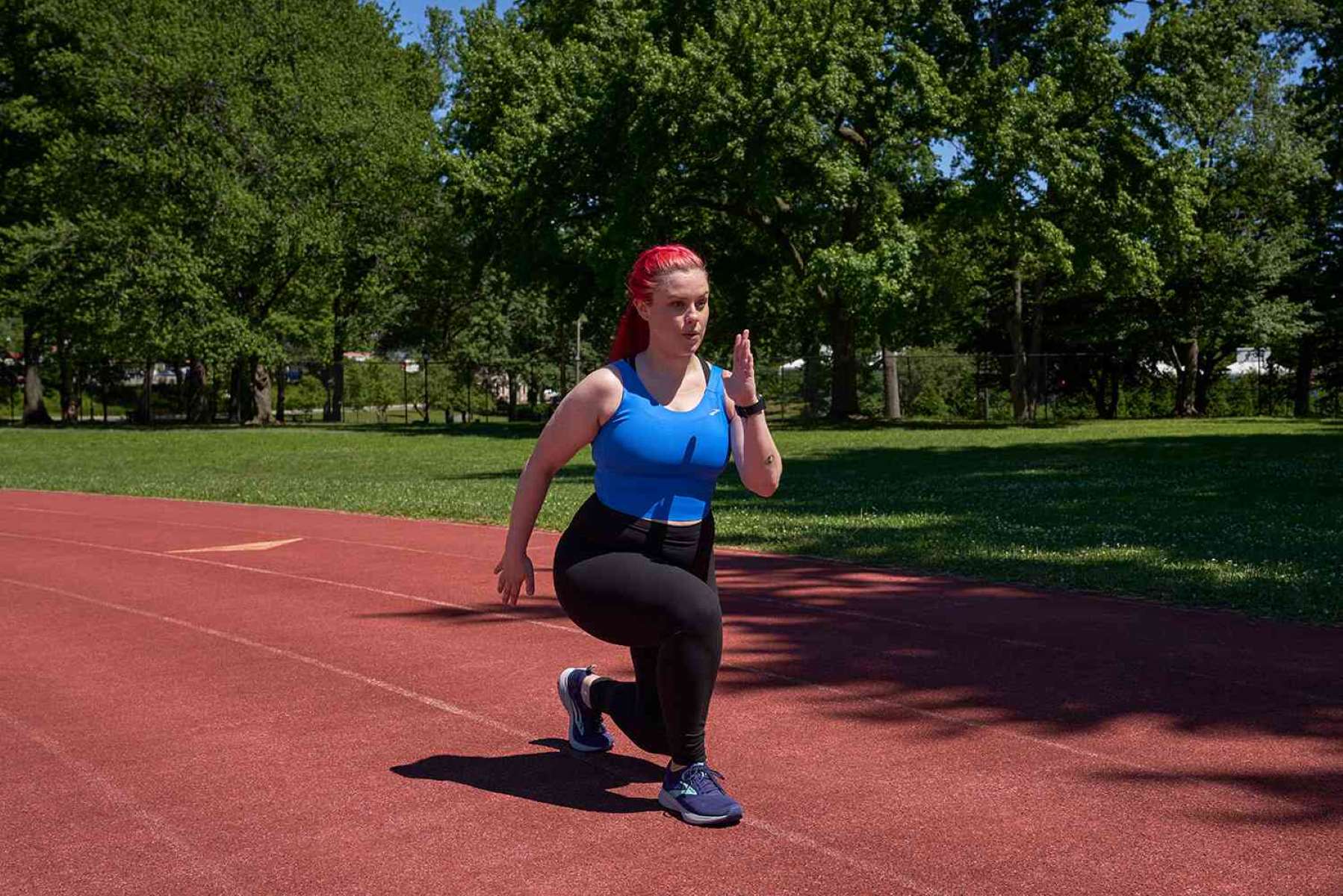Home>Misc>Featured>Long Distance Running Is An Example Of What Type Of Exercise


Featured
Long Distance Running Is An Example Of What Type Of Exercise
Modified: January 22, 2024
Discover the benefits of long distance running as a featured exercise. Improve endurance, burn calories, and challenge yourself with this popular form of physical activity.
Introduction
Long distance running is a popular form of exercise that has gained significant attention in recent years. It involves covering extended distances, typically ranging from 5 kilometers to marathons or even ultramarathons, which can exceed 100 kilometers. Long distance running offers a multitude of benefits, both physical and mental, making it a favorite among fitness enthusiasts.
What sets long distance running apart from other forms of exercise is its ability to challenge individuals both physically and mentally. It requires endurance, focus, and self-discipline to complete these extended distances. Moreover, long distance running provides an excellent opportunity to explore the outdoors, connect with nature, and enjoy the therapeutic effects of solitude.
Whether you are a seasoned athlete or a beginner, long distance running can be a rewarding and transformative experience. It is a type of exercise that engages multiple muscle groups and promotes cardiovascular fitness. Additionally, long distance running has been shown to improve mental well-being, boost self-confidence, and relieve stress.
Throughout this article, we will explore the various aspects of long distance running as a type of exercise. We will delve into the different types of exercises, the specific muscles involved, the distinction between aerobic and anaerobic exercise, as well as valuable tips on training and injury prevention.
So, whether you are lacing up your running shoes for the first time or looking to take your long distance running to the next level, join us as we dive into the world of long distance running and discover why it is considered to be a prime example of an exceptional exercise regimen.
Definition of Long Distance Running
Long distance running is a form of aerobic exercise that involves covering extended distances on foot. It is typically measured in kilometers or miles, with distances exceeding 5 kilometers considered to be long distance. This type of running requires endurance and cardiovascular fitness to sustain a steady pace over a prolonged period of time.
Long distance running can take various forms, including road running, trail running, cross-country running, and track running. Road running is the most common, conducted on paved surfaces such as roads or sidewalks, often in organized races or marathons. Trail running, on the other hand, takes place on natural terrain like forests, mountains, or parks, offering a more challenging and scenic experience. Cross-country running involves racing on a variety of terrains, combining hills, fields, and sometimes even water hazards. Lastly, track running occurs on oval tracks, where individuals compete in various distances across lanes while adhering to specific rules and regulations.
Key elements of long distance running include pacing, endurance, and mental fortitude. Runners must maintain a steady pace that allows them to cover the distance without overexerting themselves. Endurance is crucial in sustaining this pace for extended periods, pushing through fatigue and building the capacity to run longer distances over time. Mental fortitude is also essential, as long distance running often tests an individual’s resilience, determination, and ability to overcome physical and mental barriers.
Long distance running is not limited to professional athletes or experienced runners. Many individuals of different fitness levels engage in long distance running as a way to challenge themselves, improve overall health and fitness, and achieve personal goals. It can be a solo endeavor, providing an opportunity for self-reflection and mental clarity, or a social activity, allowing runners to bond with like-minded individuals and participate in races or group training sessions.
Overall, long distance running is a versatile and inclusive form of exercise that offers numerous physical and mental benefits. It encompasses various distances, terrains, and levels of competition, making it accessible to individuals with different interests and abilities. Whether you’re aiming to complete your first 10-kilometer race or training for a marathon, long distance running can be a fulfilling and empowering pursuit.
Types of Exercise
Long distance running falls under the category of aerobic exercise, which refers to physical activities that increase the body’s demand for oxygen and improve cardiovascular fitness. However, within the realm of long distance running, there are several distinct types of exercise that runners can incorporate into their training regimens. Let’s explore these different types:
- Base Runs: Base runs are the foundation of any long distance runner’s training. They involve running at a comfortable, steady pace over a moderate distance. Base runs help develop aerobic endurance and improve overall cardiovascular fitness. These runs are typically longer and slower than other types of training runs, allowing the body to adapt and build endurance over time.
- Tempo Runs: Tempo runs are a key element for improving speed and endurance. They involve running at a sustained, challenging pace that is slightly faster than a base run. Tempo runs typically last for shorter distances but require greater intensity. These runs help improve lactate threshold, which is the point at which the body produces lactic acid faster than it can clear it away. By pushing the lactate threshold higher, runners can sustain a faster pace for longer periods.
- Interval Training: Interval training involves alternating between periods of high-intensity running and recovery periods. This type of training is effective for increasing speed, power, and anaerobic capacity. During intervals, runners push themselves to run at a near-maximum effort for a specific distance or time, followed by a period of rest or easy jogging. This cycle is repeated several times within a training session, challenging the body’s cardiovascular system and improving overall running performance.
- Long Runs: Long runs are the centerpiece of training for long distance events, such as half marathons, marathons, or ultramarathons. These runs are conducted at a steady pace over an extended distance, usually longer than any other training run. Long runs build endurance, mental toughness, and help the body adapt to the demands of running for prolonged periods. They also serve as an opportunity to practice fueling strategies, hydration, and pacing for race day.
- Hill Training: Hill training involves incorporating uphill and downhill running into training runs. Uphill running builds leg strength and power, while downhill running improves eccentric muscle contractions and teaches the body to handle the impact of downhill sections during races. Hill training can be done on natural hills or using incline settings on treadmills. It challenges runners both physically and mentally and helps improve overall running efficiency.
By incorporating a combination of these different types of exercises into a training plan, long-distance runners can enhance their overall performance, improve specific aspects of their running abilities, and reduce the risk of injury.
Benefits of Long Distance Running as a Type of Exercise
Long distance running offers a wide array of benefits, making it a remarkable form of exercise for both physical and mental well-being. Let’s explore some of the key benefits of engaging in long distance running:
- Improved cardiovascular health: Long distance running is excellent for cardiovascular fitness as it strengthens the heart, improves blood circulation, and increases lung capacity. Consistent long distance running can lower blood pressure, reduce the risk of heart disease, and enhance overall cardiovascular health.
- Weight management: Long distance running is a fantastic exercise for weight loss and weight management. It burns a significant number of calories and helps individuals maintain a healthy body weight. Running regularly also boosts metabolism, even at rest, facilitating weight loss over time.
- Stronger muscles and bones: Long distance running engages multiple muscle groups, including the quadriceps, hamstrings, calves, glutes, and core. As a result, it helps build strength and endurance in these muscles. The repetitive impact of running also stimulates bone density, reducing the risk of osteoporosis and improving overall bone health.
- Mental well-being: Long distance running has profound benefits for mental health. It releases endorphins, which are natural mood boosters, and reduces stress, anxiety, and symptoms of depression. Running also provides a sense of accomplishment, boosts self-confidence, and promotes better sleep patterns.
- Increased energy and productivity: Regular long distance running enhances energy levels and improves productivity throughout the day. It stimulates the release of dopamine and serotonin, neurotransmitters that enhance focus, concentration, and cognitive function. Runners often report improved mental clarity, creativity, and increased productivity in other areas of life.
- Connection with nature and stress relief: Long distance running provides an excellent opportunity to connect with nature, whether it’s running on trails, through parks, or along scenic routes. Being in nature has been shown to reduce stress, boost mood, and improve overall well-being. It offers a break from the hustle and bustle of daily life and provides a sense of peace and tranquility.
- Goal setting and personal growth: Long distance running allows individuals to set goals and work towards achieving them. Whether it’s completing a specific distance, setting a personal record, or participating in a race, the process of training for long distance running encourages discipline, perseverance, and self-improvement. It fosters personal growth and a sense of fulfillment.
These benefits highlight the remarkable impact that long distance running can have on an individual’s physical and mental well-being. Whether you’re a seasoned runner or just starting, embracing long distance running as a type of exercise can be a transformative and rewarding journey.
Muscles Used in Long Distance Running
Long distance running engages a multitude of muscles throughout the body, as it requires a coordinated effort to propel the body forward and maintain a steady pace. While running primarily targets the muscles of the lower body, several other muscle groups play crucial roles in supporting and stabilizing the body during the repetitive motion of running. Let’s explore the main muscles involved in long distance running:
- Quadriceps: The quadriceps, located in the front of the thigh, are heavily utilized during long distance running. They are responsible for extending the knee and providing power during each stride.
- Hamstrings: The hamstrings, located at the back of the thigh, work in conjunction with the quadriceps to propel the body forward. They also assist in bending the knee and extend the hip during the running motion.
- Calves: The calf muscles, including the gastrocnemius and soleus, aid in pushing off the ground and propelling the body forward. They provide power during the toe-off phase of the running gait.
- Glutes: The gluteal muscles, including the gluteus maximus, medius, and minimus, play a crucial role in stabilizing the pelvis and providing power and propulsion during running. They also assist in controlling the movement of the hip and maintaining balance.
- Core muscles: The core muscles, including the abdominals, obliques, and lower back muscles, are essential for maintaining stability and providing support during long distance running. A strong core helps maintain proper posture and prevents excessive movement and energy loss.
- Hip flexors: The hip flexor muscles, including the iliopsoas and rectus femoris, are involved in lifting the legs during the swing phase of running. They assist in bringing the knee forward and play a crucial role in maintaining the running stride.
- Upper body muscles: While not directly involved in propulsion, the upper body muscles, including the arms, shoulders, and upper back, contribute to stability and balance during long distance running. They also assist in maintaining proper arm swing, which helps in maintaining rhythm and efficiency.
These are just some of the main muscles that are actively engaged during long distance running. It’s worth noting that long distance running is a dynamic activity that involves the coordinated effort of multiple muscle groups in the body. Strengthening and conditioning these muscles through specific exercises and training can help improve running performance, enhance endurance, and reduce the risk of injuries.
Aerobic vs. Anaerobic Exercise in Long Distance Running
Long distance running primarily falls under the category of aerobic exercise, which means it relies on the aerobic energy system to supply the necessary energy for the activity. However, there are certain aspects of long distance running that can also incorporate anaerobic exercise. Let’s explore the difference between aerobic and anaerobic exercise in the context of long distance running:
Aerobic Exercise:
Aerobic exercise, also known as “cardio,” involves continuous, sustained, and rhythmic movements that require a steady supply of oxygen to meet the body’s energy demands. In long distance running, aerobic exercise dominates as it involves running at a moderate intensity that allows the body to utilize oxygen efficiently to produce energy. During aerobic exercise, the body primarily relies on stored glycogen and fat as fuel.
Aerobic exercise in long distance running is characterized by a slow and steady pace that can be maintained for extended periods of time. It aims to improve cardiovascular endurance, strengthen the heart, and enhance the oxygen-carrying capacity of the lungs. Long distance runners often focus on building a strong aerobic base through consistent training at different distances and intensities.
Anaerobic Exercise:
Anaerobic exercise involves short bursts of high-intensity activity that exceeds the body’s ability to provide oxygen for energy production. During anaerobic exercise, the body relies on stored glycogen as the primary source of fuel. While anaerobic exercise plays a limited role in long distance running, there are certain components that incorporate anaerobic efforts. For example, sprinting during speed workouts or incline running during hill training can engage the anaerobic energy system.
These brief moments of anaerobic exertion serve to improve speed, power, and lactate threshold. By pushing the body beyond its aerobic capacity, it challenges the muscles to work at a higher intensity and adapt to greater demands. While anaerobic exercise may not be the focus of long distance running, incorporating some high-intensity efforts can enhance overall performance and running economy.
It’s important to note that while both aerobic and anaerobic exercise have their place in long distance running, the majority of the training and the actual act of running the longer distances is primarily aerobic in nature. Training plans for long distance running are designed to build endurance, improve aerobic capacity, and optimize energy utilization.
Understanding the balance between aerobic and anaerobic exercise is crucial for long distance runners. By primarily focusing on building a strong aerobic base and incorporating occasional anaerobic efforts, runners can enhance their overall performance, improve speed, and increase their ability to sustain a steady pace over longer distances.
Tips for Long Distance Running Training
Training for long distance running requires careful planning, consistent effort, and a focus on building endurance. Whether you’re a beginner or a seasoned runner, here are some valuable tips to optimize your long distance running training:
- Start gradually: If you’re new to long distance running, start gradually by gradually increasing your mileage and intensity. Allow your body to adapt to the demands of running longer distances by following a structured training plan.
- Set realistic goals: Set achievable goals that are specific, measurable, and time-bound. Whether it’s completing your first half marathon or achieving a personal best in a marathon, having clear goals will keep you motivated and focused throughout your training.
- Follow a training plan: Design or follow a training plan that includes a mix of easy runs, long runs, speed workouts, and rest days. A well-structured plan ensures proper progression, prevents overtraining, and allows for adequate recovery.
- Focus on nutrition and hydration: Eat a balanced diet with a focus on carbohydrates for energy, lean proteins for muscle repair, and healthy fats for overall health. Stay hydrated throughout the day and during your runs to optimize performance and aid in recovery.
- Invest in proper running shoes: Visit a specialty running store to get properly fitted for running shoes that suit your foot type and running style. The right shoes provide comfort, support, and reduce the risk of injury.
- Listen to your body: Pay attention to any signs of fatigue or pain. It’s crucial to listen to your body and take rest days or modify your training as needed to avoid overuse injuries.
- Include cross-training: Incorporate cross-training activities such as strength training, cycling, swimming, or yoga into your training routine. These activities help build overall strength, improve flexibility, and prevent muscle imbalances.
- Practice recovery strategies: Allow time for proper recovery after long runs or intense workouts. Implement strategies such as foam rolling, stretching, ice baths, or massage therapy to reduce muscle soreness and aid in recovery.
- Track your progress: Keep a training log to track your mileage, pace, and how you feel during each run. Monitoring your progress will help you identify trends, identify areas for improvement, and celebrate your achievements.
- Join a running group or find a training partner: Running with others can provide accountability, motivation, and make the training process more enjoyable. Look for local running groups or connect with like-minded individuals to share the journey.
Remember, consistency and patience are key to long distance running training. Be mindful of your body’s limitations and progress at a pace that is suitable for you. With dedication, perseverance, and a well-rounded approach to training, you can achieve your long distance running goals and experience the joy and fulfillment of crossing the finish line.
Common Injuries in Long Distance Running
Long distance running puts a significant amount of stress on the body, making runners susceptible to certain injuries. Understanding and being aware of these common injuries can help you take proactive measures to prevent them and seek appropriate treatment if necessary. Here are some common injuries experienced by long distance runners:
- Runner’s Knee: Also known as patellofemoral pain syndrome, runner’s knee is a common overuse injury characterized by pain around or behind the kneecap. It occurs due to improper tracking of the kneecap during running, leading to irritation and inflammation.
- Shin Splints: Shin splints cause pain along the shinbone (tibia) and are often a result of repetitive stress or overuse. The pain is typically felt on the inner edge of the shinbone and can be aggravated by running on hard surfaces or sudden increases in training intensity.
- Achilles Tendinitis: Achilles tendinitis is inflammation of the Achilles tendon, which connects the calf muscles to the heel bone. It is often caused by overuse, tight calf muscles, or insufficient warm-up. Runners with Achilles tendinitis experience pain and stiffness in the back of the ankle.
- Plantar Fasciitis: Plantar fasciitis involves inflammation of the plantar fascia, a thick band of tissue that runs along the bottom of the foot. It is characterized by sharp pain in the heel or arch of the foot, particularly in the morning or after prolonged periods of rest. Runners with high arches or flat feet are more susceptible to plantar fasciitis.
- Iliotibial (IT) Band Syndrome: IT band syndrome refers to inflammation of the iliotibial band, a thick band of tissue that runs from the hip to the knee. It is often caused by friction between the band and the knee joint, leading to pain on the outside of the knee. IT band syndrome can be aggravated by increased mileage, improper running form, or muscle imbalances.
- Stress Fractures: Stress fractures are small cracks or fractures in the bone that occur from repetitive stress and overload. They commonly occur in weight-bearing areas such as the shinbone or metatarsal bones in the foot. Stress fractures can result from a sudden increase in training intensity, inadequate rest, or improper footwear.
- Blisters and chafing: While not as severe as other injuries, blisters and chafing can cause discomfort and hinder performance. They occur due to repetitive friction or pressure on the skin, typically caused by ill-fitting shoes, moisture, or improper clothing.
Preventing injuries in long distance running is crucial for maintaining consistency and enjoying the sport. Here are some preventive measures to keep in mind:
- Gradually increase mileage and intensity to allow your body to adapt to the demands of running.
- Wear appropriate running shoes that provide proper support and cushioning for your foot type.
- Maintain a regular stretching routine to improve flexibility and prevent muscle imbalances.
- Listen to your body and take rest or recovery days when needed.
- Warm up properly before each run and cool down afterward with stretching exercises.
- Consider cross-training to strengthen muscles and prevent overuse injuries.
- Seek professional guidance to improve running form and technique.
If you experience persistent or severe pain, it’s important to consult a medical professional for proper diagnosis and treatment. Remember, early intervention and proper care can help alleviate minor issues before they become major setbacks.
Conclusion
Long distance running is more than just a form of exercise. It is a journey that challenges the body and mind, fosters personal growth, and offers a multitude of physical and mental benefits. Whether you are a novice runner or an experienced athlete, long distance running has something to offer everyone.
Throughout this article, we explored the definition of long distance running and its various types of exercises. We discussed the benefits of long distance running, such as improved cardiovascular health, weight management, stronger muscles and bones, enhanced mental well-being, increased energy, connection with nature, and personal growth.
We also delved into the specific muscles used in long distance running, highlighting the importance of proper training and conditioning to prevent common injuries. From runner’s knee to shin splints, Achilles tendinitis to plantar fasciitis, being aware of these injuries and taking preventive measures can help ensure a safe and enjoyable running experience.
In addition, we explored the distinction between aerobic and anaerobic exercise in long distance running. While long distance running primarily relies on the aerobic energy system, incorporating occasional anaerobic efforts can enhance performance and speed.
To optimize long distance running training, we provided valuable tips, including starting gradually, setting realistic goals, following a training plan, focusing on nutrition and hydration, investing in proper running shoes, listening to your body, incorporating cross-training, practicing recovery strategies, tracking progress, and seeking support from running groups or training partners.
In conclusion, long distance running is an exceptional form of exercise that offers a combination of physical, mental, and emotional benefits. It is a journey of self-discovery, perseverance, and resilience. Whether you’re aiming to complete your first 10-kilometer race or training for a marathon, long distance running has the power to transform lives and leave a lasting impact.









